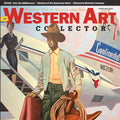Shonto Begay Exhibition at Arizona State Museum
By Medicine Man Gallery on
Sparkle on the Surface of the Water
Tucson's Arizona State Museum to exhibit works by Navajo storyteller, painter Shonto Begay
Published online courtesy Western Art Collector, March, 2014
In Dine (Navajo) tradition an infant is named only after laughing for the first time. Shonto Begay must have been named shortly after his first breath since his humor and sparkling eyes seem to be something he brought with him when he was born.
The son of a medicine man and a mother who was a sheep herder and weaver, Begay was forcibly removed from his family and taken to a Bureau of Indian Affairs boarding school with all the other children of his generation. There he resisted the name given him by the government and escaped into art. He chose the name Shonto for the town where he was born, and Begay, the name of his great-great-grandmother. Shonto means "sparkle on the surface of the water" and sums up both the artist and his work.
On vacations from the Indian School, he tended sheep and absorbed the landscape as well as the physical and mythical culture of his people. He has developed his own style of post-impressionism in which each distinct brushstroke echoes the syllables of the chants and songs that have always been part of his life. Shonto writes, Shonto paints, and Shonto Speaks - which is the title of an exhibition of his paintings at the Arizona State Museum in Tucson. A storyteller and the writer of more than 10 books, Begay has written short, poetic texts to accompany the 11 paintings from the 1980s to the present.
An avid promoter and defender of the traditional culture of the Dine, he also portrays the harsh realities of life today. He comments on the painting Helpless (1996): "In a shack we called 'The Battered Men Shelter' for men battering themselves a safe place to escape to. At times, the shelter is full of guys sleeping it off as depicted in this image. The only conscience being is the cat. A place wives look first looking for lost husbands. A sad place, a hard and rough place at times. The shadow of the viewer is lingering at the threshold, posing the question, 'Do I join them? I have a choice. I looked in on them and left.'"
The uneasy balance between traditional ways and modern technology is depicted in Navajo Power Plant (1987). He writes, "My uncle collects medicine plants on the mesa as the power plant of another kind stabs darkened sky. He collects medicine, sifting earth from its roots with arthritic hands. He collects for local healings while the other power plant provides powers to places beyond the horizons. He whispers ancient prayers into the heavens just as the other plant spews poisons into the same breeze that carries my uncle's petitions to the Holy Ones."



